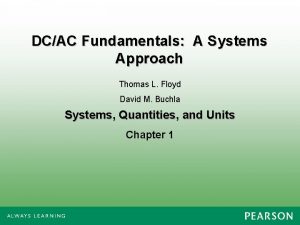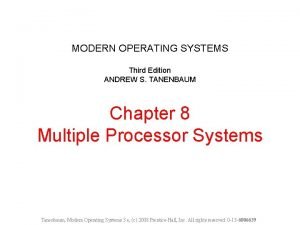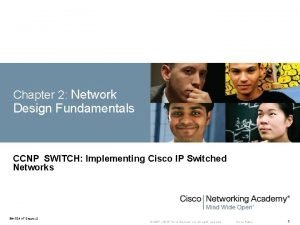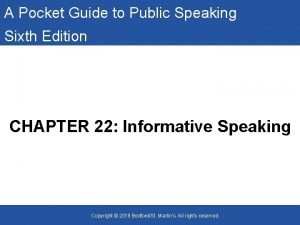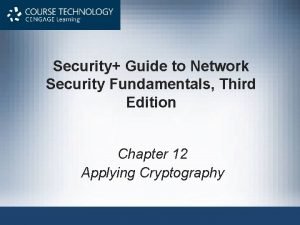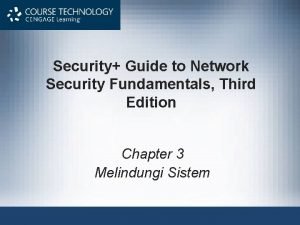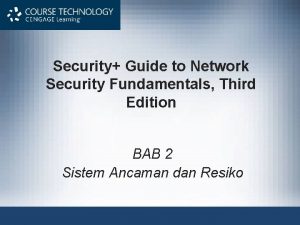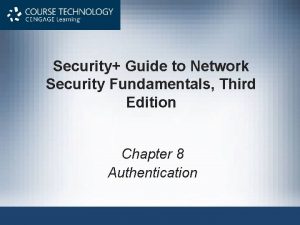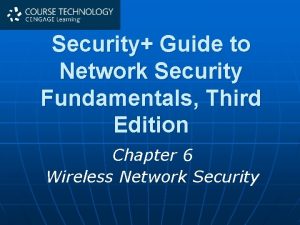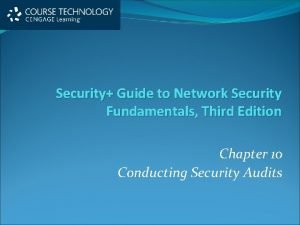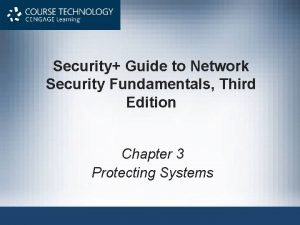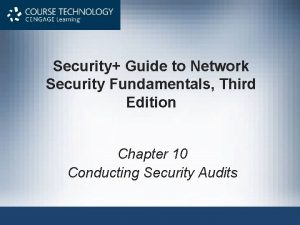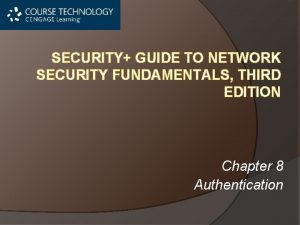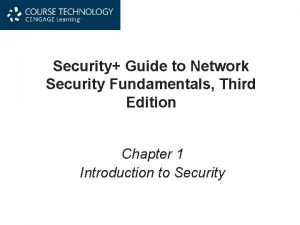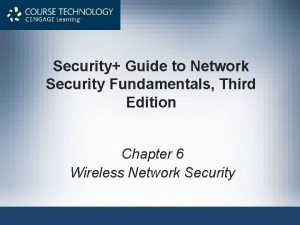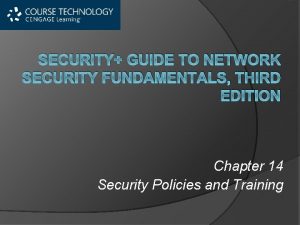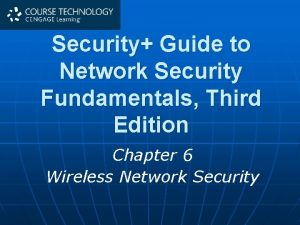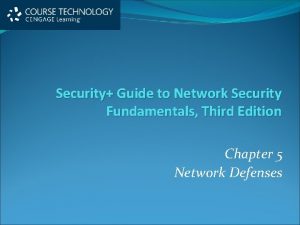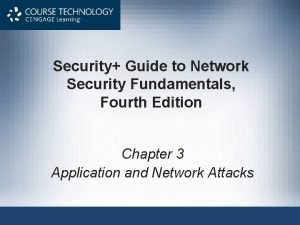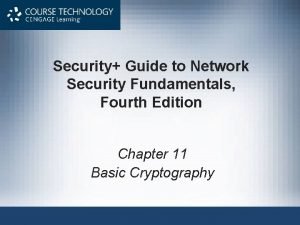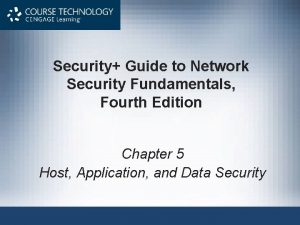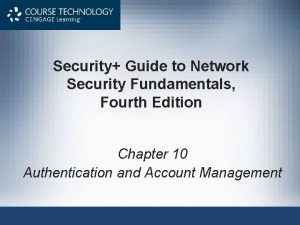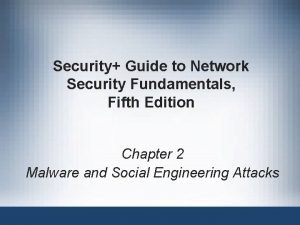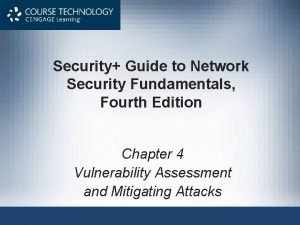Security Guide to Network Security Fundamentals Third Edition





















































- Slides: 53

Security+ Guide to Network Security Fundamentals, Third Edition Chapter 13 Business Continuity

Objectives • • Define environmental controls Describe the components of redundancy planning List disaster recovery procedures Describe incident response procedures Security+ Guide to Network Security Fundamentals, Third Edition 2

Environmental Controls • Preventing disruptions or even attacks through environmental controls involves using fire suppression, proper shielding, and configuring HVAC systems Security+ Guide to Network Security Fundamentals, Third Edition 3

Fire Suppression • Damage inflicted as a result of a fire continues to remain high • Fire suppression is an important concern for the safety of employees and business continuity • In order for a fire to occur, four entities must be present at the same time: – A type of fuel or combustible material – Sufficient oxygen to sustain the combustion – Enough heat to raise the material to its ignition temperature – A chemical reaction that is the fire itself Security+ Guide to Network Security Fundamentals, Third Edition 4

Fire Suppression (continued) Security+ Guide to Network Security Fundamentals, Third Edition 5

Fire Suppression (continued) • It is important to use the correct fire suppression system – Not only to extinguish the fire but also minimize any residual damage • Fires are divided into five categories – See Table 13 -2 Security+ Guide to Network Security Fundamentals, Third Edition 6

Fire Suppression (continued) Security+ Guide to Network Security Fundamentals, Third Edition 7

Security+ Guide to Network Security Fundamentals, Third Edition 8

Fire Suppression (continued) • In a server closet or room that contains computer equipment – Using a handheld fire extinguisher is not recommended because the chemical contents can contaminate electrical equipment • Instead, stationary fire suppression systems should be: – Integrated into the building’s infrastructure – Release the suppressant in the room Security+ Guide to Network Security Fundamentals, Third Edition 9

Security+ Guide to Network Security Fundamentals, Third Edition 10

Electromagnetic Shielding • Computer systems, cathode ray tube monitors, printers, and similar devices all emit electromagnetic fields – That are produced by signals or the movement of data • Van Eck phreaking – A form of eavesdropping in which special equipment is used to pick up telecommunication signals or data within a computer device • By monitoring the electromagnetic fields Security+ Guide to Network Security Fundamentals, Third Edition 11

Electromagnetic Shielding (continued) • Faraday cage – A metallic enclosure that prevents the entry or escape of an electromagnetic field – Consists of a grounded fine-mesh copper screening • Telecommunications Electronics Material Protected from Emanating Spurious Transmissions (TEMPEST) – A secret US government standard – Intended to “reduce the conducted and radiated emissions from within the sensitive environment to an undetectable level outside the shielded enclosure in uncontrolled areas” Security+ Guide to Network Security Fundamentals, Third Edition 12

Electromagnetic Shielding (continued) Security+ Guide to Network Security Fundamentals, Third Edition 13

HVAC • Heating, ventilation, and air conditioning (HVAC) systems – Provide and regulate heating and cooling for data centers • Controlling environmental factors can reduce electrostatic discharge (ESD) – The sudden flow of electric current between two objects, which can destroy electronic equipment • Another consideration regarding HVAC is the location of computer equipment outside of the data center Security+ Guide to Network Security Fundamentals, Third Edition 14

Redundancy Planning • One of the primary ways to ensure business continuity is to use redundancy planning – Which involves building excess capacity in order to protect against failures • Redundancy planning can involve redundancy for servers, storage, networks, power, and even sites Security+ Guide to Network Security Fundamentals, Third Edition 15

Servers • A crash of a single server that supports a critical application can have a significant impact • Single point of failure – The loss of one entity would adversely affect the organization • One common approach is for the organization to design the network infrastructure – So that multiple servers are incorporated into the network yet appear to users and applications as a single computing resource Security+ Guide to Network Security Fundamentals, Third Edition 16

Servers (continued) • Server cluster – The combination of two or more servers that are interconnected to appear as one • There are two types of server clusters: – Asymmetric server cluster • A standby server exists only to take over for another server in the event of its failure – Symmetric server cluster • Every server in the cluster performs useful work Security+ Guide to Network Security Fundamentals, Third Edition 17

Servers (continued) Security+ Guide to Network Security Fundamentals, Third Edition 18

Storage • Mean time between failures (MTBF) – Refers to the average (mean) time until a component fails, cannot be repaired, and must be replaced – Calculating the MTBF involves taking the total time measured divided by the total number of failures observed • Fault tolerance – The ability to endure failures – Prevents a single problem from escalating into a major failure – Can often be achieved by maintaining redundancy Security+ Guide to Network Security Fundamentals, Third Edition 19

Storage (continued) • RAID (Redundant Array of Independent Drives) – Uses multiple hard disk drives for increased reliability and performance • The most common levels of RAID are: – RAID Level 0 (striped disk array without fault tolerance) – RAID Level 1 (mirroring) – RAID Level 5 (independent disks with distributed parity) – RAID 0+1 (high data transfer) Security+ Guide to Network Security Fundamentals, Third Edition 20

Security+ Guide to Network Security Fundamentals, Third Edition 21

Security+ Guide to Network Security Fundamentals, Third Edition 22

Security+ Guide to Network Security Fundamentals, Third Edition 23

Networks • Redundant network – “Waits” in the background during normal operations – Uses a replication scheme to keep its copy of the live network information current • Virtually all network components can be duplicated to provide a redundant network • In addition, some organizations contract with more than one Internet Service Provider (ISP) for remote connectivity Security+ Guide to Network Security Fundamentals, Third Edition 24

Power • Uninterruptible power supply (UPS) – A device that maintains power to equipment in the event of an interruption in the primary electrical power source • Two primary types of UPS – Off-line UPS – On-line UPS • UPS systems can also communicate with the network operating system on a server – To ensure that an orderly shutdown occurs Security+ Guide to Network Security Fundamentals, Third Edition 25

Power (continued) • A UPS can complete the following tasks: – Send a message to the network administrator’s computer, or page or telephone the network manager to indicate that the power has failed – Notify all users that they must finish their work immediately and log off – Prevent any new users from logging on – Disconnect users and shut down the server • Because a UPS can only supply power for a limited amount of time, some organizations turn to using a backup generator to create power Security+ Guide to Network Security Fundamentals 26

Sites • Redundancy can also be planned for the entire site itself • Hot site – Generally run by a commercial disaster recovery service – Allows a business to continue computer and network operations to maintain business continuity • Cold site – Provides office space but the customer must provide and install the equipment needed to continue operations Security+ Guide to Network Security Fundamentals, Third Edition 27

Sites (continued) • Warm site – Has all of the equipment installed but does not have active Internet or telecommunications facilities, and does not have current backups of data Security+ Guide to Network Security Fundamentals, Third Edition 28

Disaster Recovery Procedures • Disaster recovery – Procedures and processes for restoring an organization’s IT operations following a disaster – Focuses on restoring computing and technology resources to their former state • Disaster recovery procedures include planning, disaster exercises, and performing data backups Security+ Guide to Network Security Fundamentals, Third Edition 29

Planning • Disaster recovery plan (DRP) – A written document that details the process for restoring IT resources • Following an event that causes a significant disruption in service • Comprehensive in its scope, a DRP is intended to be a detailed document that is updated regularly • All disaster recovery plans are different Security+ Guide to Network Security Fundamentals, Third Edition 30

Planning (continued) Security+ Guide to Network Security Fundamentals, Third Edition 31

Planning (continued) • Most disaster recovery plans address the common features included in the following typical outline: – – – Unit 1: Purpose and Scope Unit 2: Recovery Team Unit 3: Preparing for a Disaster Unit 4: Emergency Procedures Unit 5: Restoration Procedures • It is important that a good DRP contains sufficient detail Security+ Guide to Network Security Fundamentals, Third Edition 32

Planning (continued) Security+ Guide to Network Security Fundamentals, Third Edition 33

Disaster Exercises • Disaster exercises are designed to test the effectiveness of the DRP • Objectives of these disaster exercises: – Test the efficiency of interdepartmental planning and coordination in managing a disaster – Test current procedures of the DRP – Determine the strengths and weaknesses in responses Security+ Guide to Network Security Fundamentals, Third Edition 34

Data Backups • Data backup – Information copied to a different medium and stored at an offsite location so that it can be used in the event of a disaster • Five basic questions that should be answered: – – – What information should be backed up? How often should it be backed up? What media should be used? Where should the backup be stored? What hardware or software should be used? Security+ Guide to Network Security Fundamentals, Third Edition 35

Data Backups (continued) • Backup software can internally designate which files have already been backed up – By setting an archive bit in the properties of the file • Backing up to magnetic tape has been the mainstay of data backups for over 30 years • Grandfather-son backup system – Divides backups into three sets: a daily backup (son), a weekly backup (father), and a monthly backup (grandfather) Security+ Guide to Network Security Fundamentals, Third Edition 36

Security+ Guide to Network Security Fundamentals, Third Edition 37

Data Backups (continued) Security+ Guide to Network Security Fundamentals, Third Edition 38

Security+ Guide to Network Security Fundamentals, Third Edition 39

Data Backups (continued) • Recovery point objective (RPO) – The maximum length of time that an organization can tolerate between backups • Recovery time objective (RTO) – The length of time it will take to recover the data that has been backed up • An alternative to using magnetic tape is to back up to magnetic disk – Such as a large hard drive or RAID configuration – This is known as disk to disk (D 2 D) Security+ Guide to Network Security Fundamentals, Third Edition 40

Data Backups (continued) • D 2 D offers better RPO than tape – However, as with any hard drive, the D 2 D drive may be subject to failure or data corruption • Disk to disk to tape (D 2 D 2 T) – Combines the best of magnetic tape and magnetic disk – Uses the magnetic disk as a temporary storage area • Continuous data protection (CDP) – Performs continuous data backups that can be restored immediately Security+ Guide to Network Security Fundamentals, Third Edition 41

Data Backups (continued) Security+ Guide to Network Security Fundamentals, Third Edition 42

Data Backups (continued) Security+ Guide to Network Security Fundamentals, Third Edition 43

Incident Response Procedures • Incident response procedures include using forensic science and properly responding to a computer forensics event Security+ Guide to Network Security Fundamentals, Third Edition 44

What Is Forensics? • Forensics, also known as forensic science – The application of science to questions that are of interest to the legal profession • Computer forensics – Can attempt to retrieve information—even if it has been altered or erased—that can be used in the pursuit of the attacker or criminal – Also used to limit damage and loss of control of data Security+ Guide to Network Security Fundamentals, Third Edition 45

What Is Forensics? (continued) • The importance of computer forensics is due in part to the following: – High amount of digital evidence – Increased scrutiny by the legal profession – Higher level of computer skill by criminals Security+ Guide to Network Security Fundamentals, Third Edition 46

Responding to a Computer Forensics Incident • Secure the crime scene – The computer forensics response team should be contacted whenever digital evidence needs to be preserved and serve as first responders – The physical surroundings of the computer should be clearly documented – Photographs of the area should be taken before anything is touched – The computer should be photographed from several angles – Cables connected to the computer should be labeled Security+ Guide to Network Security Fundamentals, Third Edition 47

Responding to a Computer Forensics Incident (continued) • Preserve the evidence – Team should first capture any volatile data – The team should next focus on the hard drive • Mirror image backups replicate all sectors of a computer hard drive, including all files and any hidden data storage areas • Chain of custody – Documents that the evidence was under strict control at all times and no unauthorized person was given the opportunity to corrupt the evidence Security+ Guide to Network Security Fundamentals, Third Edition 48

Responding to a Computer Forensics Incident (continued) • Examine for evidence – After a computer forensics expert creates a mirror image of a system: • Original system is secured • Mirror image is examined to reveal evidence – Includes searching word processing documents, email files, spreadsheets, and other documents for evidence – Hidden clues can also be mined and exposed • Including the Windows page file – Another source of hidden data is called slack Security+ Guide to Network Security Fundamentals, Third Edition 49

Responding to a Computer Forensics Incident (continued) • Examine for evidence (continued) – RAM slack • Can contain any information that has been created, viewed, modified, downloaded, or copied since the computer was last booted – Drive file slack (sometimes called drive slack) • Contains remnants of previously deleted files or data from the format pattern associated with disk storage space that has yet to be used by the computer – An additional source of hidden clues can be gleaned from metadata, or data about data Security+ Guide to Network Security Fundamentals, Third Edition 50

Security+ Guide to Network Security Fundamentals, Third Edition 51

Security+ Guide to Network Security Fundamentals, Third Edition 52

Summary • Environmental controls are designed to prevent disruptions to an organization • One method for ensuring business continuity is to use redundancy planning • Power redundancy can be attained by using an uninterruptible power supply (UPS) • Disaster recovery is defined as the procedures and processes for restoring an organization’s IT operations following a disaster • Forensic science is the application of science to questions that are of interest to the legal profession Security+ Guide to Network Security Fundamentals, Third Edition 53
 Security guide to network security fundamentals
Security guide to network security fundamentals Security guide to network security fundamentals
Security guide to network security fundamentals Security guide to network security fundamentals
Security guide to network security fundamentals Fundamentals of corporate finance canadian edition
Fundamentals of corporate finance canadian edition Fundamentals of corporate finance 3rd canadian edition
Fundamentals of corporate finance 3rd canadian edition Computer security fundamentals 4th edition
Computer security fundamentals 4th edition William stallings network security essentials 5th edition
William stallings network security essentials 5th edition Modulo table
Modulo table Cryptography and network security 6th edition pdf
Cryptography and network security 6th edition pdf Cryptography and network security 4th edition
Cryptography and network security 4th edition Cryptographic systems are generically classified by
Cryptographic systems are generically classified by Pearson cryptography and network security
Pearson cryptography and network security Gj mount classification of dental caries
Gj mount classification of dental caries Gj mount classification of dental caries
Gj mount classification of dental caries Fundamentals of information systems 9th edition
Fundamentals of information systems 9th edition Fundamentals of information systems 9th edition
Fundamentals of information systems 9th edition Fluid mechanics fundamentals and applications 3rd edition
Fluid mechanics fundamentals and applications 3rd edition Digital fundamentals tenth edition floyd
Digital fundamentals tenth edition floyd Machining fundamentals 10th edition
Machining fundamentals 10th edition Fundamentals of organizational communication 9th edition
Fundamentals of organizational communication 9th edition Fundamentals of organizational communication 9th edition
Fundamentals of organizational communication 9th edition Digital fundamentals 10th edition
Digital fundamentals 10th edition Digital fundamentals by floyd
Digital fundamentals by floyd Dc/ac fundamentals a systems approach
Dc/ac fundamentals a systems approach Management fundamentals 8th edition
Management fundamentals 8th edition Fundamentals of information systems
Fundamentals of information systems Fundamentals of corporate finance fifth edition
Fundamentals of corporate finance fifth edition Corporate finance 6th edition
Corporate finance 6th edition Fundamentals of abnormal psychology ninth edition
Fundamentals of abnormal psychology ninth edition Fundamentals of information systems 9th edition
Fundamentals of information systems 9th edition Thermal conduction resistance
Thermal conduction resistance The fundamentals of political science research 2nd edition
The fundamentals of political science research 2nd edition Principles of economics third edition pdf
Principles of economics third edition pdf Carboxylic acid h3o+ reaction
Carboxylic acid h3o+ reaction Organic chemistry third edition david klein
Organic chemistry third edition david klein Business mathematics third edition
Business mathematics third edition Distributed systems third edition
Distributed systems third edition Lifespan development third edition
Lifespan development third edition Lifespan development third edition
Lifespan development third edition Cell biology third edition
Cell biology third edition Joey's first 14 quiz grades in a marking period were
Joey's first 14 quiz grades in a marking period were What is the osi security architecture?
What is the osi security architecture? Wireless security in cryptography
Wireless security in cryptography Electronic mail security in network security
Electronic mail security in network security Mis chapter 6
Mis chapter 6 Using mis (10th edition)
Using mis (10th edition) Provate security
Provate security Ccna exploration network fundamentals
Ccna exploration network fundamentals Campus network design fundamentals
Campus network design fundamentals Florida real estate broker's guide 6th edition
Florida real estate broker's guide 6th edition Florida real estate broker's guide 6th edition
Florida real estate broker's guide 6th edition Pocket guide to public speaking 6th edition
Pocket guide to public speaking 6th edition Wpan security
Wpan security Marking bad clusters data hiding technique
Marking bad clusters data hiding technique























